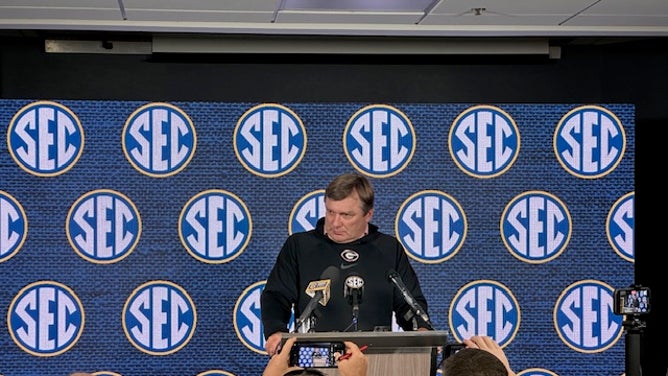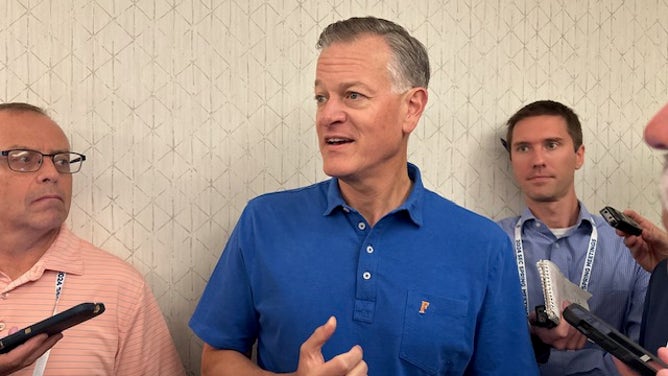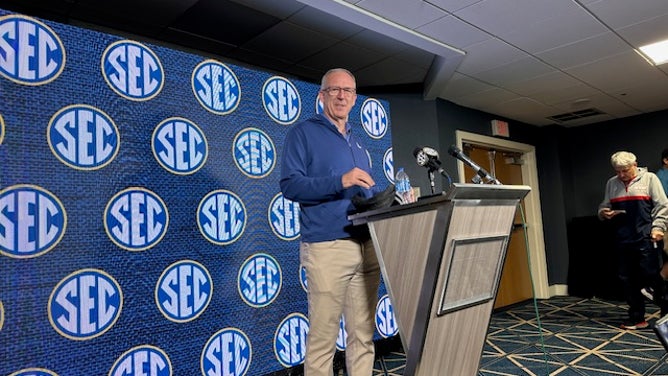More Questions Than Answers Coming Out Of SEC Spring Meetings, Coaches Look For Guidance On Future Roster Caps
DESTIN, Fla. - If you were looking for answers regarding what the future of college athletics looks like, at least from the SEC's standpoint, you will not find them coming out of spring meetings this week in Florida.
After the news broke last week that conferences and the NCAA had settled on a monetary figure regarding its ‘House’ antitrust lawsuit, many fans around the country thought there would be plans put into place on how this would shape the future of collegiate athletics.
I would tell you to hold-off on getting any type of concrete answers on how this is going to permanently shape the athletic world. While there have been ongoing conversations centered around revenue sharing, roster caps and ‘injury reports’, the consensus from most folks involved in three-days of meetings in Florida is that there is a lot more work to do.
Now, let me be clear. SEC coaches and administrators were not headed to Florida this week to vote on any type of resolutions or new proposals regarding the outcome of the settlement. If anything, this was more of a seminar on what's potentially to come in the athletic world, and coaches trying to figure out where their sport falls into the new world.
How Many Players Will Be Allowed On A Football Roster?
One of the biggest questions regarding the sport of football is how rosters will be shaped in the future. Will there be an 85-man limit for each team? Can the number jump to 100? One of the most important components of the future of college football hinges on this question.
Let me be clear, every coach that has publicly spoken this week has been against cutting the roster number down to 85, which would eliminate walk-on positions, while also having a major effect on practices and preparation.
"I mean, practice how you play and numbers could get low to where you have to overplay players compared to where you haven’t in the past," Lane Kiffin noted. "So, there are some very big safety concerns. And the ability to practice well enough to develop young players also."
Texas A&M head coach Mike Elko said that he was ‘strongly against’ cutting the number down to 85 players, mentioning that ‘it’s something really bad for the sport'.

SEC Spring Meetings brought more questions than answers, and that's not a bad thing during this crazy time. (Photo: Trey Wallace, OutKick)
The problem lies in some sports having to cut the number of players, a lot of it due to financial impacts, along with the aspect of revenue sharing in the sport. The more players, the more money is spent on one sport. This is why coaches spent a majority of their time together in Destin discussing the ramifications of this move to trim rosters.
"It's so stupid. Do they understand what that would do to our roster when it comes to practice?," one head coach mentioned this week. "It's not as if I can go add players to my team during the season if a number of my guys get hurt, so why put us in the spot when it comes to changing the amount of players we can have. I understand the world is changing from a money standpoint, but we have to figure out a better solution."
While this will continue to be argued over the next six months, the conversations inside each room this week were more centered around the ‘what if’, compared to ‘ok, lets do this’. There were zero votes taken, and the majority of coaches said that they will have more questions that need to be answered down the road.
"Tap the brakes before you start focusing on a particular number, but it's very fair to say that those programs that had 125, 130 players on the roster will have to get used to having fewer," Oklahoma AD Joe Castiglione said Wednesday evening.
What About Availability Reports (Gambling) In College Football?
One of the other important topics that had coaches and athletic directors asking questions was centered around the potential for more advanced availability reports, like you see in the professional ranks. Yes, some of this has to do with the growing gambling industry that has seen a number of problems when it comes to prop-bets recently.
At the top of this list is the integrity of the game, along with consistency in the sport when it comes to knowledge of whether or not players are injured heading into games.
"I understand from just a consistency across the conference trying to pull that all together and even across the country with the different conferences," Alabama head coach Kalen DeBoer mentioned. "So some consistency is certainly something I understand. I'm open to the idea, just want to understand more about what, what the expectation would be and what that format would look like."

Florida AD Scott Stricklin. SEC Spring Meetings brought more questions than answers, and that's not a bad thing during this crazy time. (Photo: Trey Wallace, OutKick)
So how would you penalize the folks that don't report injuries or keep up the integrity of the game? Well, newly minted SEC head coach Steve Sarkisian had a pretty good idea of how to prevent coaches from messing with the sport.
"Fine us. That’s what they do in the NFL. The NFL has figured this out. We don’t have to reinvent the wheel. If you don't report a guy, fine us. We all like the money we make," Steve Sarkisian noted.
Honestly, it's not a bad idea, and something I could see take shape over the next few years, as we continue to move towards the professional model.
Where Are We Headed In Collegiate Athletics?
Well, the easy answer is we are headed towards a professional model in college athletics. Whether that's revenue sharing, contracts signed by players, injury reports, roster caps, it's all headed in one direction.
As for when we will get there, that's going to take some time. But, the likelihood of implementation of some of these ideas will happen before the 2025 season. The revenue sharing part will incur hiccups along the way, especially with Title IX. When it comes to equal revenue, there are a ton of questions that still need to be answered, and I can promise you this group of athletic directors and commissioner Sankey want to get it right, and not end up back in a courtroom.

SEC Commissioner Greg Sankey speaks before the kickoff of spring meetings. (Photo: Trey Wallace, OutKick)
More meetings are going to be held, conversations will continue via Zoom and in-person meetings before Media Days in Dallas. But my main takeaway from the last three days talking with coaches and administrators at SEC Spring meetings is that these folks have a long ways to go, and more questions than answers.
If we're being honest with each other, this is exactly how I felt this would play-out before arriving along the Gulf Coast this week. Administrators and coaches are headed back home with a lot to discuss, and plans to start putting in-motion.
They've got time, but the clock is officially ticking.